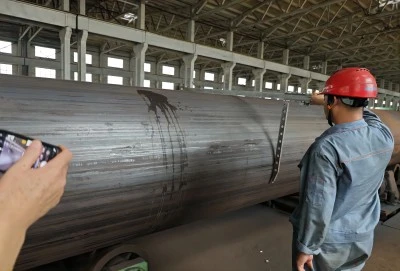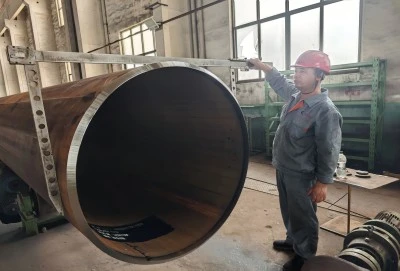In the world of steel piping, ASTM A135 pipe stands out as a versatile and reliable option for various applications. This article delves into the specifications, materials, and uses of A135 pipe, providing valuable insights for engineers, contractors, and industry professionals. We'll explore the composition, manufacturing process, and performance characteristics that make this pipe type a popular choice in many sectors.
|
|
|
Specifications and Manufacturing
ASTM A135 pipe is a type of welded steel pipe manufactured according to the standards set by the American Society for Testing and Materials (ASTM). This specification covers electric-resistance-welded steel pipe, primarily used in fire protection systems and other related applications. The pipe is known for its strength, durability, and ability to withstand high pressures, making it an excellent choice for critical installations.
The manufacturing process of ASTM A135 pipe involves electric resistance welding (ERW), a method that ensures a strong and reliable seam. In this process, the edges of a steel strip are heated to welding temperature by electrical resistance and then forged together under pressure. This results in a pipe with a uniform wall thickness and consistent mechanical properties throughout its length.
A135 pipes are available in various sizes, typically ranging from 1/4 inch to 20 inches in nominal diameter. The wall thickness can vary, usually following standard pipe schedules such as SCH10, SCH40, or SCH80. This variety allows for flexibility in design and application, catering to different project requirements and specifications.
Materials Used in Manufacturing ASTM A135 Pipe
The quality and performance of ASTM A135 pipe largely depend on the materials used in its manufacture. The primary material for these pipes is steel, specifically chosen for its strength, weldability, and corrosion resistance. The steel used in A135 pipes must meet specific chemical composition requirements to ensure consistent quality and performance.
The steel used in ASTM A135 pipes typically contains:
- Carbon: 0.30% maximum
- Manganese: 1.20% maximum
- Phosphorus: 0.035% maximum
- Sulfur: 0.035% maximum
These compositional limits are crucial in determining the pipe's mechanical properties, weldability, and overall performance. The low carbon content, for instance, ensures good weldability, which is essential for the ERW process and subsequent fabrication or installation.
In addition to the base steel, ASTM A135 pipes may undergo various treatments or coatings to enhance their performance or appearance. These can include galvanization for improved corrosion resistance or painting for easier identification and aesthetic purposes. However, it's important to note that such treatments must not compromise the pipe's basic properties or its ability to meet ASTM A135 standards.
Pressure and Temperature Conditions
ASTM A135 pipes are designed to withstand specific pressure and temperature conditions, making them suitable for a wide range of applications. The exact pressure ratings depend on factors such as the pipe's diameter, wall thickness, and grade. Generally, these pipes are capable of handling pressures up to 300 psi (pounds per square inch) or more, depending on the specific grade and size.
Regarding temperature, A135 pipes are typically suitable for use in environments ranging from -20°F to 300°F (-29°C to 149°C). This wide temperature range makes them versatile for various applications, from cold water systems to hot water distribution networks.
It's crucial to note that the actual pressure and temperature limits for a specific ASTM A135 pipe installation should be determined based on the pipe's grade, size, and the specific requirements of the application. Proper engineering calculations and adherence to relevant codes and standards are essential to ensure safe and reliable performance.
The pressure-temperature ratings of ASTM A135 pipes are often expressed in terms of their working pressure at room temperature. However, as temperatures increase, the allowable working pressure typically decreases. This relationship is crucial for engineers and designers to consider when specifying A135 pipes for high-temperature applications.
Classification of ASTM A135 Pipe: Grade A vs. Grade B
ASTM A135 pipes are classified into two main grades: Grade A and Grade B. These grades differ in their mechanical properties and intended applications, providing options to suit various project requirements.
Grade A ASTM A135 pipe:
- Minimum yield strength: 30,000 psi (205 MPa)
- Minimum tensile strength: 48,000 psi (330 MPa)
- Typically used in general-purpose applications
Grade B ASTM A135 pipe:
- Minimum yield strength: 35,000 psi (240 MPa)
- Minimum tensile strength: 60,000 psi (415 MPa)
- Preferred for applications requiring higher strength and pressure ratings
Grade B pipes, with their higher strength properties, are more commonly used in fire protection systems and other applications where increased pressure resistance is necessary. The choice between Grade A and Grade B depends on factors such as the specific application requirements, local building codes, and engineering specifications.
It's worth noting that while these are the standard grades, some manufacturers may offer variations or custom grades to meet specific project needs. Always consult with a qualified engineer or the pipe manufacturer to ensure the chosen grade is suitable for your intended application.
Applications and Advantages
ASTM A135 pipes find extensive use in various industries and applications, primarily due to their reliability, strength, and cost-effectiveness. Some of the key applications include:
- Fire Protection Systems: A135 pipes are widely used in sprinkler systems and other fire protection installations. Their ability to withstand high pressures and their reliability make them an ideal choice for these critical safety applications.
- Water Distribution: These pipes are often used in municipal water supply systems, industrial water networks, and irrigation systems.
- HVAC Systems: A135 pipes can be found in heating, ventilation, and air conditioning systems, particularly in large commercial or industrial settings.
- Industrial Piping: Various industrial processes utilize ASTM A135 pipes for transporting fluids or gases under moderate pressure and temperature conditions.
- Construction: These pipes are used in structural applications, such as support columns or scaffolding, leveraging their strength and durability.
The advantages include:
- Cost-effectiveness: The ERW manufacturing process allows for efficient production, making these pipes a cost-effective option for many applications.
- Consistency: The standardized manufacturing process ensures uniform quality and properties throughout the pipe length.
- Weldability: The low carbon content of the steel used makes these pipes easy to weld, facilitating installation and modification.
- Versatility: Available in various sizes and grades, ASTM A135 pipes can be adapted to a wide range of applications.
- Reliability: Adherence to ASTM standards ensures these pipes meet specific quality and performance criteria.
At Longma Group, one of China's leading ERW/LSAW steel pipe manufacturers since 2003, we're committed to delivering exceptional quality and service. With an annual output exceeding 1,000,000 tons by the end of 2023, we have the capacity to meet the demands of projects of all sizes.
Our ASTM A135 pipe is a prime example of our dedication to excellence. Available in Grade B, it features ERW welding and offers a wide range of outer diameters (1/4" - 20") and thicknesses (SCH10 - SCH160), making it suitable for various applications.
Ready to explore how our solutions can enhance your next project? Contact us today at info@longma-group.com to learn more about our products and services.














